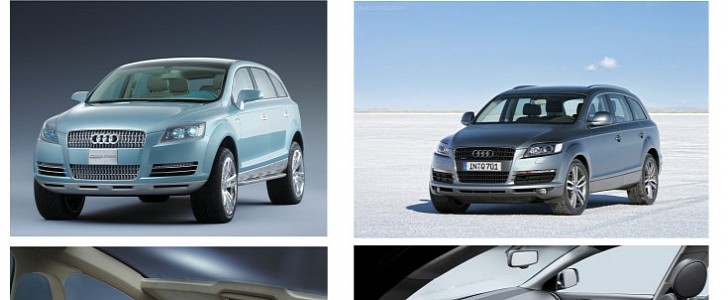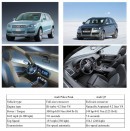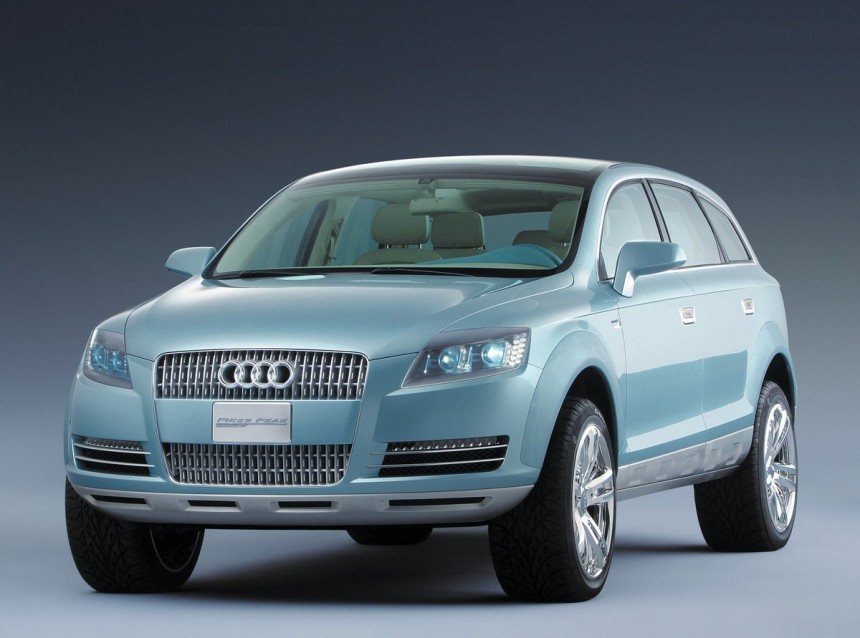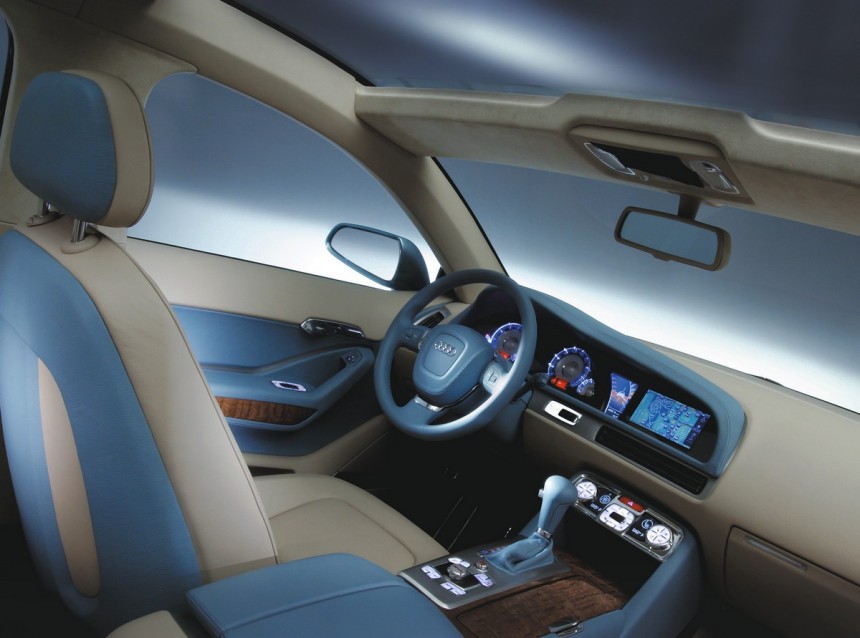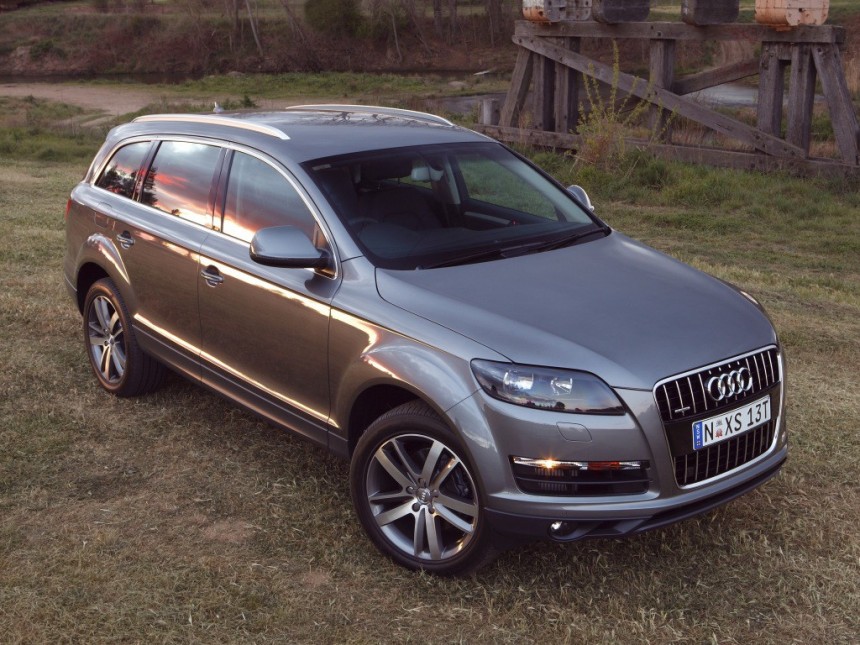Audi escaped extinction in the '70s, when Volkswagen bought the Ingolstadt factory to expand the production capacity for the Beetle, but ended up agreeing that the four-ring brand may continue making its model 80, which eventually saved the brand.
We are continuing our journey through the Concept 2 Reality series with the Audi Pikes Peak concept car, which evolved into the Audi Q7. Let's find out why the German carmaker even made it, and see if the production model fulfilled the promises made in 2003.
When Audi started to pretend a seat at the premium carmaker's table at the beginning of the '90s, it wasn't quite there yet. Moreover, it lacked a full-size all-wheel-drive crossover. Some of the other German carmakers dared more, and had already launched their competitors earlier. Mercedes-Benz built the ML as a body-on-frame vehicle in 1997, while BMW approached customers with the unibody 1999 X5 based on the 5-Series platform. Audi was taken by surprise. It didn't know if it had to follow them or not. Moreover, its experience in building such vehicles was almost zero.
BMW learned from Land Rover, while Mercedes-Benz had years of experience with the C-Class. Both carmakers succeeded. Well, Audi had to rely on what Volkswagen learned from the Touareg. In 2003, after a five-month development, the carmaker introduced the Pikes Peak concept car at the North American International Auto Show. It was the start of a whole new chapter.
The new SUV took the world by surprise. Audi was already on the verge of new, unexplored markets. It already produced the TT and the Allroad when nobody believed they're gonna make 'em. So, this time, everybody knew that it would be produced, especially if they wanted to keep up with the other two German rivals.
The Pikes Peak Concept-car appeared in its pale-blue color named "Polar Silver" on the Cobo-hall in January 2003. It was one of the few concept cars where the engine mattered the least. A new design language started at the front with the wide and tall, split in two, grille. It was the inception of the singleframe grille, which became a standard feature on most Audi vehicles more than a decade later.
The vehicle's flared wheel arches and muscular lines of the rear quarter panels emphasized a sporty appearance. Some features were new for the German carmaker, but not unusual for the American market. For instance, the retractable running boards, which eased the ingress and egress from the car.
Other novelties were the LED fog lights and the adaptive Xenon brights. Sure, nowadays, all these might seem outdated. Yet, in 2003, Xenon was reserved only for premium brands. As for the LEDs, these were far from the 2020 efficiency - yet, they showed a glimpse of the future.
Inside, the carmaker placed an innovative interior based on two main elements: styling and technology. The former was achieved by introducing matt-brushed aluminum and Japanese "Tamo" ashwood trims. In addition, the panoramic glass roof was fitted with a retractable interior cover to enhance the interior luminosity ensured a pleasant atmosphere.
Audi installed a six-seat interior layout, in a 2-2-2 fashion, with the second and third rows foldable, so the trunk could reach 68 cu-ft (1,950 liters) of space. The power-assisted tailgate could have been open with the car's remote control, that was part of the keyfob to ease the loading and unloading. Another feature that didn't make it to the production was the independent opening of the rear window. That was something BMW had since 1987.
In those times, Audi used the MMI term instead of "infotainment." It means Multi Media Information, and it is still used on its today's vehicles. It was controlled via a button placed between the front seats on the center console. BMW already had the iDrive unit in 2002 on the 7-Series, co-developed with Nokia. But the concept car could afford the luxury to install an additional set of screens for the rear passengers. Nowadays, you can get those online or from Walmart. But back then, that was the dream for any mom and dad with their kids in the rear seats asking the same annoying question "are we there yet?"
Two years after the Pikes Peak presentation, Audi introduced the production version, the Q7, at the 2005 Frankfurt Motorshow. It didn't steal the show, though. Instead, the king of the show title went to the W221 Mercedes-Benz S-Class. Yet, the Q7 came close and gathered enough attention.
The production model featured a similar front fascia, but it lost the running boards. That wasn't a big deal. Europeans didn't use them anyway. At the front, the car sported a more conventional layout with halogen fog lamps and Xenon only as an option. From the design point of view, we might say that the Q7 followed the same blueprints as the Pikes Peak. Kudos for that, Audi!
But, on the inside, the design team (or the beancounters) chose a cautious and wiser approach. Since the carmaker already knew its customers, it understood that the Japanese ashwood wouldn't be a smart decision either. So it replaced the beautifully crafted Pikes Peak interior with something that resembled the regular A6. At least, they could have placed something from the A8 flagship.
The MMI system remained, even though it looked awkward with its red-on-black screen. But, at least, it offered an iPod or MP3 player connectivity. There was no USB back then, and the Bluetooth technology was good only for phone calls.
Audi kept a five-seat layout, with a split-folding bench for the rear passengers. Unlike the Pikes Peak, it offered a seven-seat option, something that neither BMW X5 nor the Mercedes-Benz ML could. Time showed that the other two Germans were right. Nobody asked for a 7-sear luxobarge in that segment.
If the Viper exceeded its customer's expectations, we might say that the Q7 ticked all the promised features. Strangely, it didn't offer the concept car's engine, which was a carry-over and tuned powerplant from the Audi RS6. But it provided a wide choice of diesel engines, including a monster V12 TDI since 2009, which was good to tow a Sukhoi Superjet 100 passenger plane, which had a maximum take-off weight of nearly 50 metric tons (198,020 lbs). Of course, we think it was not fully loaded. But still, it was a good marketing stunt.
When Audi started to pretend a seat at the premium carmaker's table at the beginning of the '90s, it wasn't quite there yet. Moreover, it lacked a full-size all-wheel-drive crossover. Some of the other German carmakers dared more, and had already launched their competitors earlier. Mercedes-Benz built the ML as a body-on-frame vehicle in 1997, while BMW approached customers with the unibody 1999 X5 based on the 5-Series platform. Audi was taken by surprise. It didn't know if it had to follow them or not. Moreover, its experience in building such vehicles was almost zero.
BMW learned from Land Rover, while Mercedes-Benz had years of experience with the C-Class. Both carmakers succeeded. Well, Audi had to rely on what Volkswagen learned from the Touareg. In 2003, after a five-month development, the carmaker introduced the Pikes Peak concept car at the North American International Auto Show. It was the start of a whole new chapter.
The new SUV took the world by surprise. Audi was already on the verge of new, unexplored markets. It already produced the TT and the Allroad when nobody believed they're gonna make 'em. So, this time, everybody knew that it would be produced, especially if they wanted to keep up with the other two German rivals.
The vehicle's flared wheel arches and muscular lines of the rear quarter panels emphasized a sporty appearance. Some features were new for the German carmaker, but not unusual for the American market. For instance, the retractable running boards, which eased the ingress and egress from the car.
Other novelties were the LED fog lights and the adaptive Xenon brights. Sure, nowadays, all these might seem outdated. Yet, in 2003, Xenon was reserved only for premium brands. As for the LEDs, these were far from the 2020 efficiency - yet, they showed a glimpse of the future.
Inside, the carmaker placed an innovative interior based on two main elements: styling and technology. The former was achieved by introducing matt-brushed aluminum and Japanese "Tamo" ashwood trims. In addition, the panoramic glass roof was fitted with a retractable interior cover to enhance the interior luminosity ensured a pleasant atmosphere.
In those times, Audi used the MMI term instead of "infotainment." It means Multi Media Information, and it is still used on its today's vehicles. It was controlled via a button placed between the front seats on the center console. BMW already had the iDrive unit in 2002 on the 7-Series, co-developed with Nokia. But the concept car could afford the luxury to install an additional set of screens for the rear passengers. Nowadays, you can get those online or from Walmart. But back then, that was the dream for any mom and dad with their kids in the rear seats asking the same annoying question "are we there yet?"
Two years after the Pikes Peak presentation, Audi introduced the production version, the Q7, at the 2005 Frankfurt Motorshow. It didn't steal the show, though. Instead, the king of the show title went to the W221 Mercedes-Benz S-Class. Yet, the Q7 came close and gathered enough attention.
The production model featured a similar front fascia, but it lost the running boards. That wasn't a big deal. Europeans didn't use them anyway. At the front, the car sported a more conventional layout with halogen fog lamps and Xenon only as an option. From the design point of view, we might say that the Q7 followed the same blueprints as the Pikes Peak. Kudos for that, Audi!
The MMI system remained, even though it looked awkward with its red-on-black screen. But, at least, it offered an iPod or MP3 player connectivity. There was no USB back then, and the Bluetooth technology was good only for phone calls.
Audi kept a five-seat layout, with a split-folding bench for the rear passengers. Unlike the Pikes Peak, it offered a seven-seat option, something that neither BMW X5 nor the Mercedes-Benz ML could. Time showed that the other two Germans were right. Nobody asked for a 7-sear luxobarge in that segment.
If the Viper exceeded its customer's expectations, we might say that the Q7 ticked all the promised features. Strangely, it didn't offer the concept car's engine, which was a carry-over and tuned powerplant from the Audi RS6. But it provided a wide choice of diesel engines, including a monster V12 TDI since 2009, which was good to tow a Sukhoi Superjet 100 passenger plane, which had a maximum take-off weight of nearly 50 metric tons (198,020 lbs). Of course, we think it was not fully loaded. But still, it was a good marketing stunt.
